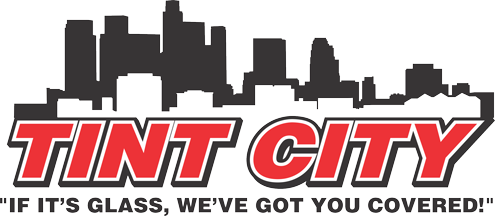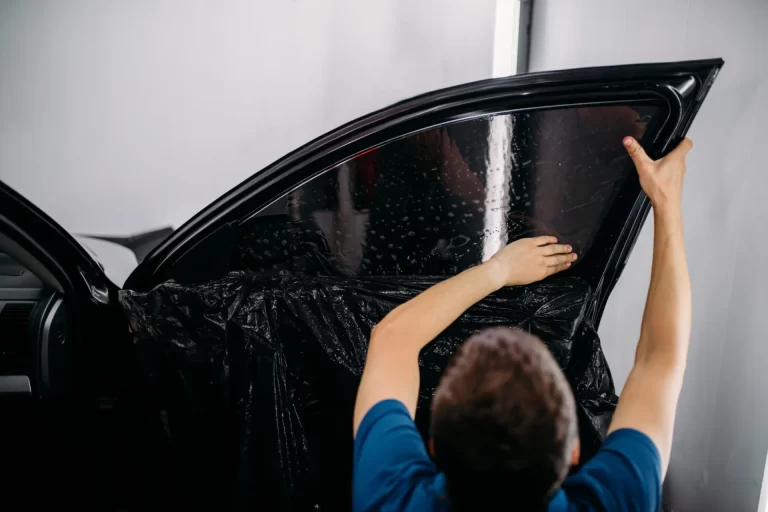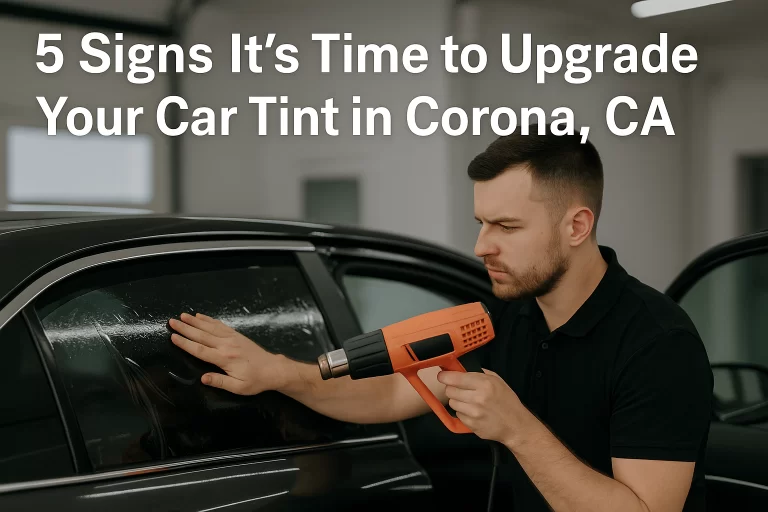Introduction to Automotive Window Tinting in Southern California
Automotive window tinting has become increasingly popular in Southern California due to the region’s sunny and warm climate. With intense sunlight and high temperatures being a regular occurrence, tinted windows offer a range of benefits that enhance driving comfort and protect vehicle interiors.
One of the primary advantages of window tinting is its ability to block harmful ultraviolet (UV) rays from entering the vehicle. Prolonged exposure to UV radiation can cause premature aging and cracking of dashboard materials, upholstery, and other interior components. By blocking up to 99% of UV rays, tinted windows help preserve the condition of your vehicle’s interior, maintaining its value and appearance for longer.
In addition to UV protection, window tinting helps reduce heat buildup inside the vehicle. The tinted film acts as an insulator, reflecting a significant portion of the sun’s infrared rays, which are responsible for heating up the cabin. This results in a cooler and more comfortable driving experience, especially during the hot summer months in Southern California.
Furthermore, tinted windows provide enhanced privacy and security for vehicle occupants. The darker tint makes it difficult for outsiders to see inside the vehicle, deterring potential thieves and increasing personal safety.
It’s important to note that window tinting in California is subject to specific regulations and laws. The state has established tint darkness limits for different types of vehicles, ensuring that drivers maintain adequate visibility and safety on the roads. Professional window tinting companies in Southern California are well-versed in these regulations and can guide you through the legal requirements.
Overall, automotive window tinting offers numerous benefits for Southern California residents, including UV protection, reduced heat buildup, enhanced privacy, and compliance with state regulations. By choosing a reputable window tinting service provider, you can enjoy a comfortable and stylish driving experience while safeguarding your vehicle’s interior and complying with local laws.
Top Window Tinting Service Providers in Southern California
Southern California is home to numerous reputable window tinting service providers, each offering their unique expertise and specialties. Among the most prominent names in the region is Tint City, a company that has garnered a stellar reputation for its exceptional workmanship and commitment to customer satisfaction.
Tint City boasts multiple locations strategically situated across Southern California, ensuring convenient access for clients throughout the region. With a team of highly skilled and experienced technicians, they specialize in various window tinting solutions tailored to meet the diverse needs of their clientele.
Whether you’re seeking enhanced privacy, reduced heat and glare, or improved energy efficiency, Tint City offers a wide range of premium tinting films from leading manufacturers. Their expertise extends to both automotive and residential applications, ensuring a seamless and professional installation process every time.
In addition to Tint City, Southern California is home to several other notable window tinting service providers. Companies like SunTek, Llumar, and 3M have established a strong presence in the region, offering top-quality tinting products and services. These industry leaders often collaborate with local installers, ensuring that their cutting-edge tinting solutions are applied with precision and expertise.
Many of these service providers specialize in specific areas, such as commercial tinting for office buildings and storefronts, or custom tinting solutions for high-end vehicles. This diversity in offerings allows customers to find the perfect fit for their unique needs, whether it’s enhancing the aesthetics of their car, reducing energy costs for their home, or ensuring compliance with local regulations.
Regional Benefits of Window Tinting in Southern California
Southern California’s sunny and warm climate makes automotive window tinting a highly desirable investment for vehicle owners in the region. The intense sunlight and high temperatures can take a toll on both the interior of your car and your comfort while driving. Window tinting offers several key benefits tailored to the unique climate and driving conditions in Southern California.
UV Protection: The powerful ultraviolet rays from the Southern California sun can cause long-term damage to your vehicle’s interior, leading to faded upholstery, cracked dashboards, and other signs of premature aging. High-quality window tinting films act as a barrier, blocking up to 99% of harmful UV rays, protecting your car’s interior and keeping it looking like new for years to come.
Heat Reduction: Tinted windows significantly reduce the amount of heat that enters your vehicle, making your air conditioning system more effective and efficient. This not only keeps you more comfortable during those hot Southern California summers but also helps reduce the strain on your vehicle’s cooling system, potentially extending its lifespan.
Energy Savings: By reducing the amount of heat entering your car, window tinting can lead to substantial energy savings. Your air conditioning system won’t have to work as hard to maintain a comfortable temperature, resulting in improved fuel efficiency and lower emissions.
Privacy and Security: Tinted windows provide an added layer of privacy, making it more difficult for prying eyes to see into your vehicle. This can be particularly beneficial in crowded urban areas or when carrying valuable items in your car. Additionally, tinted windows can act as a deterrent to potential thieves, as they cannot easily see what’s inside your vehicle.
Glare Reduction: The bright Southern California sunshine can create intense glare, making it difficult to see clearly while driving. Window tinting films help reduce this glare, improving visibility and making your driving experience safer and more comfortable, especially during early morning and late afternoon hours when the sun is low on the horizon.
By addressing these regional benefits, automotive window tinting becomes an invaluable investment for Southern California vehicle owners. Not only does it enhance your driving comfort and protect your car’s interior, but it also contributes to energy savings and improved safety on the road.
Types of Window Tinting Films Available
Window tinting films come in various types, each with its own unique properties and benefits. Understanding the different options available is crucial in making an informed decision that aligns with your needs and preferences. Let’s explore the most common types of window tinting films:
Dyed Window Tinting Films
Dyed films are among the most affordable and widely available options. They are made by injecting dyes into the film material, providing a consistent shade throughout the tint. These films effectively block a significant amount of heat and UV rays, offering decent privacy and glare reduction. However, they may have a shorter lifespan compared to other options, as the dyes can fade over time due to exposure to sunlight.
Metalized Window Tinting Films
Metalized films incorporate microscopic metallic particles, typically aluminum or other metals, into the film’s construction. These particles reflect a substantial amount of heat and UV radiation, providing excellent heat rejection and privacy. Metalized films offer superior durability and longevity compared to dyed films. However, they can interfere with electronic signals, potentially causing issues with GPS, radio, and cellular reception.
Ceramic Window Tinting Films
Ceramic tints are considered the premium option in the window tinting industry. They are made with non-metallic ceramic particles that effectively block heat, UV rays, and infrared light. These films offer exceptional heat rejection, glare reduction, and privacy without compromising visibility or electronic signal transmission. Ceramic tints are highly durable and resistant to fading, ensuring long-lasting performance. However, they tend to be more expensive than other types of tinting films.
Hybrid Window Tinting Films
Hybrid films combine the benefits of different tinting technologies, such as dyed and metalized or ceramic and metalized components. These films aim to provide the best of both worlds, offering excellent heat rejection, UV protection, and privacy while minimizing potential drawbacks like signal interference or fading. Hybrid films often strike a balance between performance and affordability, making them a popular choice for many vehicle owners.
When choosing the right window tinting film, consider factors such as your budget, desired level of heat rejection, privacy needs, and potential interference with electronic devices. Each type of film has its pros and cons, and consulting with a reputable window tinting professional can help you make an informed decision tailored to your specific requirements.
Choosing the Right Tint Shade and Darkness Level
When it comes to automotive window tinting, selecting the right shade and darkness level is crucial for achieving the desired look, functionality, and legal compliance. In Southern California, there are specific regulations regarding tint darkness limits that must be adhered to.
Legal tint limits in California vary depending on the type of vehicle and window location. For sedans, the front windshield can only have a non-reflective tint above the manufacturer’s AS-1 line (typically 4-5 inches from the top). The front side windows must allow more than 70% of light transmission, while the rear and rear side windows can have any darkness level.
For SUVs, trucks, and vans, the front side windows must allow more than 70% of light transmission, while the rear and rear side windows can have any darkness level. It’s important to note that these regulations are subject to change, and it’s advisable to check with local authorities for the most up-to-date information.
Visibility considerations are also essential when choosing a tint shade. While darker tints may provide better heat rejection and privacy, they can also impair visibility, especially at night or in low-light conditions. It’s recommended to strike a balance between aesthetics, functionality, and safety.
Aesthetic preferences play a significant role in selecting the right tint shade. Some individuals prefer a sleek, blacked-out look, while others opt for a more subtle, limo-tinted appearance. Popular tint shades range from light charcoal to deep black, with varying levels of metallic or ceramic components that can enhance the overall appearance.
Ultimately, the ideal tint shade and darkness level should be a combination of personal preferences, legal compliance, and practical considerations. Consulting with professional window tinting experts in Southern California can help you make an informed decision that meets your specific needs and requirements.
Window Tinting Installation Process and Quality Assurance
The installation process for automotive window tinting is a crucial step that requires precision and expertise. At reputable tinting service providers in Southern California, the process typically involves the following steps:
- Surface Preparation: The vehicle’s windows are thoroughly cleaned and decontaminated to ensure a smooth and blemish-free surface for the tint film application.
- Cutting and Patterning: Experienced technicians carefully measure and cut the window tint film to match the exact dimensions and curvatures of each window, ensuring a seamless and precise fit.
- Application: Using specialized tools and techniques, the tint film is meticulously applied to the vehicle’s windows, starting from the center and working outwards to eliminate any air bubbles or wrinkles.
- Trimming and Finishing: Once the film is applied, the technicians skillfully trim away any excess material, ensuring a clean and professional finish around the window edges.
- Curing and Drying: The tinted windows are then left to cure and dry for a specified period, allowing the adhesive to set properly and the film to adhere securely to the glass.
Quality assurance is a top priority for reputable window tinting service providers in Southern California. They typically employ the following measures to ensure the highest standards of workmanship:
- Trained and Certified Technicians: Reputable tinting companies invest in ongoing training and certification programs for their technicians, ensuring they stay up-to-date with the latest techniques and industry best practices.
- Quality Control Inspections: After the installation process, the vehicle undergoes a thorough quality control inspection to identify and address any potential issues, such as bubbles, peeling, or misalignments.
- Warranties and Guarantees: Most reputable tinting service providers in Southern California offer comprehensive warranties and guarantees on their work, covering issues like bubbling, peeling, or discoloration for a specified period.
By choosing a professional and experienced window tinting service provider in Southern California, you can ensure a flawless installation process, meticulous attention to detail, and the peace of mind that comes with a quality-assured service backed by warranties and guarantees.
Caring for Tinted Windows and Maximizing Lifespan
Proper care and maintenance are essential to ensure your automotive window tint lasts for years to come. With the right cleaning techniques and precautions, you can maximize the lifespan of your tinted windows and enjoy their benefits for a long time.
Cleaning and Maintenance Tips
- Use a soft, clean cloth or a squeegee to wipe down the tinted windows. Avoid using abrasive materials or harsh chemicals, as they can scratch or damage the tint film.
- For stubborn dirt or grime, mix a few drops of mild soap with water and gently wipe the tinted surface. Rinse thoroughly with clean water and dry with a microfiber cloth.
- Avoid using ammonia-based cleaners, as they can cause the tint film to discolor or peel over time.
- Clean the tinted windows regularly to prevent the buildup of dirt, dust, or contaminants, which can degrade the tint quality.
Avoiding Damage
- Be cautious when opening and closing car doors, as the tint film can be scratched or torn by sharp objects or excessive force.
- Avoid using ice scrapers or other hard tools on tinted windows, as they can easily damage the film.
- Park your vehicle in shaded areas whenever possible to minimize exposure to direct sunlight, which can accelerate the aging process of the tint.
- Refrain from rolling down tinted windows all the way, as this can cause the film to crease or wrinkle over time.
Expected Lifespan
With proper care and maintenance, high-quality automotive window tints can last anywhere from 5 to 10 years or more. However, the lifespan can vary depending on factors such as the type of tint film used, exposure to sunlight and heat, and the overall care and handling of the tinted windows. By following the recommended cleaning and maintenance practices, you can ensure your tinted windows look great and perform optimally for years to come.
Cost Considerations for Window Tinting in Southern California
When it comes to automotive window tinting in Southern California, the cost can vary significantly depending on several factors. However, it’s essential to understand that investing in high-quality window tinting can provide long-term benefits and potential savings in the long run.
Average Pricing
On average, the cost of window tinting for a standard four-door sedan or compact car in Southern California ranges from $200 to $400. This price typically includes the tinting film, labor, and any necessary materials for the installation process. Larger vehicles, such as SUVs or trucks, may cost more due to the increased surface area and complexity of the installation.
Factors Affecting Cost
Several factors can influence the overall cost of window tinting in Southern California:
- Tint Film Quality: Higher-quality tint films, such as ceramic or metallic films, tend to be more expensive but offer superior performance, durability, and heat rejection capabilities.
- Vehicle Size and Complexity: As mentioned earlier, larger vehicles or those with complex window shapes may require more labor and materials, resulting in higher costs.
- Tint Shade and Darkness Level: Darker tints or those with specialized properties (e.g., privacy or security tints) may cost more than standard tints.
- Installation Quality: Reputable tinting service providers with experienced technicians and high-quality installation processes may charge slightly more, but they ensure a professional and long-lasting result.
Potential Long-Term Savings
While the initial investment in window tinting may seem substantial, it can provide long-term savings in various ways:
- Energy Efficiency: High-quality window tints can significantly reduce the amount of heat entering your vehicle, reducing the need for excessive air conditioning and lowering fuel consumption.
- Interior Protection: Tinted windows help protect your vehicle’s interior from harmful UV rays, preventing fading and cracking of upholstery, dashboards, and other interior components.
- Resale Value: A well-maintained and professionally tinted vehicle can potentially fetch a higher resale value compared to an untinted vehicle.
- Comfort and Health Benefits: Tinted windows can reduce glare and eye strain, making your driving experience more comfortable and potentially reducing the risk of skin damage from prolonged UV exposure.
By considering the long-term benefits and potential savings, investing in high-quality window tinting from a reputable service provider can be a wise decision for Southern California vehicle owners.
Laws and Regulations for Window Tinting in California
When it comes to window tinting in California, there are specific laws and regulations in place to ensure road safety and visibility for drivers. These regulations vary based on the type of window being tinted and the vehicle’s classification. It’s crucial to understand and comply with these laws to avoid potential fines and penalties.
For sedans, coupes, and other passenger vehicles, the front windshield is subject to the strictest regulations. In California, the front windshield can only have non-reflective tint on the top 4 inches of the windshield. Any tint below this area is illegal and can result in hefty fines.
The front side windows (driver and passenger) are also regulated. The tint darkness on these windows cannot exceed a visible light transmission (VLT) level of 70%. This means that at least 70% of the available light must pass through the tinted windows.
For rear windows and rear windshields, the regulations are more lenient. There are no specific restrictions on the level of tint darkness, allowing for darker tints to be applied to these areas.
It’s important to note that these regulations apply to all vehicles registered in California, regardless of where the tinting was performed. Failure to comply with these laws can result in fines ranging from $25 to $200 for the first offense, with potential vehicle impoundment for repeat offenses.
Additionally, law enforcement officers have the authority to conduct tint meter tests to measure the VLT levels of your tinted windows. If your tint is found to be in violation, you may be required to remove the tint or face additional penalties.
To ensure compliance and avoid potential legal issues, it’s recommended to work with reputable window tinting service providers who are well-versed in California’s tinting laws and regulations. They can guide you in selecting the appropriate tint levels and ensure a proper installation that meets all legal requirements.
Choosing the Best Window Tinting Option for Your Needs
When it comes to selecting the ideal window tinting solution for your vehicle, there are several factors to consider. The right choice will depend on your specific needs, preferences, and the type of vehicle you own.
Climate and Sun Exposure: Southern California is known for its abundant sunshine and warm climate. If you spend a lot of time driving during peak sun hours, you may want to opt for a darker tint shade to maximize heat rejection and UV protection. This can help keep your vehicle’s interior cooler and reduce the risk of sun damage to upholstery and interior surfaces.
Privacy and Security: Tinted windows offer an added layer of privacy and security by making it more difficult for outsiders to see into your vehicle. If this is a priority for you, consider a darker tint shade or a more reflective tint film.
Vehicle Type: The type of vehicle you own can also influence your window tinting choice. For example, larger SUVs or trucks may benefit from a darker tint to enhance privacy and reduce interior heat buildup, while smaller sedans or coupes may look better with a lighter tint shade.
Personal Preferences: Ultimately, your personal preferences will play a significant role in choosing the best window tinting option. Some drivers prefer a more subtle, lightly tinted look, while others prioritize maximum heat rejection and privacy. Consider your driving habits, aesthetic preferences, and the overall look you want to achieve.
Legal Compliance: It’s crucial to ensure that your window tinting choice complies with California’s laws and regulations. Generally, the front windshield and front side windows have stricter tint limits to maintain visibility for the driver.
For most vehicles, a tint shade in the range of 35% to 50% visible light transmission (VLT) is a popular choice that offers a balance of heat rejection, privacy, and legal compliance. However, if you have specific needs or preferences, consult with a reputable window tinting service provider for personalized recommendations based on your vehicle and local regulations.




